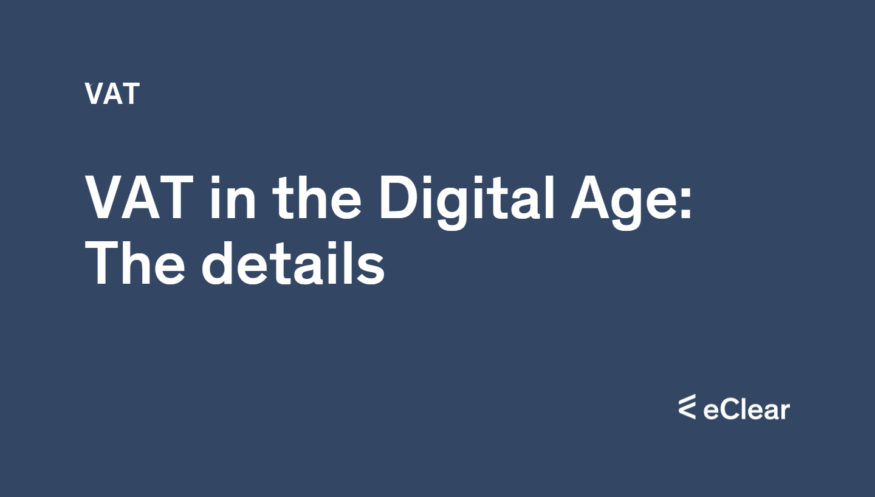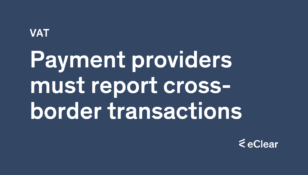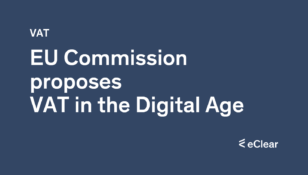At the same time, new figures indicate that the “VAT gap” (the difference between expected and actual VAT revenues collected) in the EU will amount to €93 billion in 2020. According to conservative estimates, a quarter of this amount is directly attributable to VAT fraud related to EU trade, which remains a significant problem. At a time when governments are relying on sustainable revenues to weather the current economic uncertainty, efforts to stem these losses must be accelerated.
Businesses seeking to take advantage of the Single Market, especially SMEs, currently have to deal with up to 27 national VAT systems, each with its reporting requirements. This fragmentation can create a significant administrative burden and financial cost for businesses looking to grow or enter other EU markets. At the same time, the lack of clarity on how the online platform economy should be treated for VAT purposes has created an unfair playing field vis-à-vis the more traditional economy, particularly in the accommodation and transport sectors.
To address these issues, the Commission has committed in its Tax Action Plan 2020 to bring forward measures to modernise VAT reporting obligations, strengthen Member States’ ability to track cross-border transactions, introduce a single EU VAT registration for businesses and update VAT rules for the platform economy.
The proposals
The VAT in the Digital Age (ViDA) package takes full advantage of technological and digital advances to create an updated VAT system better equipped to tackle criminal VAT fraud. It allows Member States to collect €11 billion more in VAT revenue annually over the next ten years. At the same time, the proposal will help businesses in the EU, especially SMEs.
The proposals in detail
Move to real-time digital reporting based on e-invoice for businesses operating across borders in the EU and a harmonised framework for domestic transactions:
The new system will introduce real-time digital reporting of transactions for VAT purposes based on e-invoicing. Once operational, the system will provide Member States with valuable information to control cross-border transactions and strengthen the fight against cross-border VAT fraud while reducing business administration and compliance costs. To make the best use of this data for VAT control and anti-fraud purposes, Member States will also be equipped with the appropriate administrative cooperation tools. The move to e-invoicing will help reduce VAT fraud by up to €11 billion annually.
Updated VAT rules for passenger transport and short-term accommodation platforms:
Under the new rules, platform operators should be responsible for collecting VAT where traders do not do so (e.g. because they are small businesses not usually required to register for VAT) and for paying this VAT to the tax authorities. Together with other clarifications, this should ensure a consistent approach across Member States and help to ensure a level playing field for online and traditional accommodation and transport services. It will also make life easier for SMEs using the platforms, as they will no longer have to worry about complying with different VAT rules across Europe.
The introduction of a single VAT registration across the EU
Building on the already existing “one-stop-shop” model for e-commerce traders, the proposal will further reduce the challenges businesses wishing to sell to consumers in more than one Member State have to register in other Member States. With this reform, cross-border traders can register in only one Member State for their sales to consumers across the EU and the transfer of goods for storage in other Member States.
Once registered in one Member State, they will then be able to fulfil their VAT obligations through a single online portal and communicate exclusively with the tax administration of that Member State in one language, even if their sales are made across the EU. Smaller businesses, especially those looking to expand, will benefit from the simpler administration introduced by the new rules. The proposal also requires online platforms to register for the OSS for imports, which should further improve VAT compliance. The announced measures are expected to help Member States collect up to €18 billion more in VAT revenue annually over the next ten years. Businesses are expected to save €5 billion per year in compliance costs over the same period.
Digital reporting requirements
How do businesses in the EU currently report their VAT?
Currently, businesses that carry out their sales in other EU Member States have to submit a so-called “recapitulative statement” (EC Sales List) to their national tax authority, which gives an overall view of the goods and services they have sold to businesses in other EU Member States during the relevant period and which are taxable in that Member State. This information is then passed on to other Member States, which helps the tax authorities to ensure that VAT is correctly accounted for and paid.
Currently, however, businesses must only submit a recapitulative statement four times a year in some Member States. As VAT fraud can happen in a short time, these reporting obligations do not allow the authorities to identify suspicious or fraudulent transactions quickly. The information reaches the other Member States too late – at best, up to four months later. The data is also not detailed enough, which seriously affects Member States’ ability to fight VAT fraud.
At the same time, some Member States have already introduced real-time digital reporting solutions for domestic transactions – with considerable success. However, such individual measures can lead to fragmentation across the EU, imposing an average burden of €4 billion per year on businesses and making cross-border controls inefficient.
How will the new system work in practice?
Once the new rules are in place, businesses in the EU will issue electronic invoices for cross-border transactions and automatically report a subset of the data from these invoices to their tax administration according to a European standard. They will no longer have to report monthly as “recapitulative statements” as they do now, as this information will be made available through their electronic invoices.
To make the best use of the reported data, national tax administrations will exchange it via a new IT system that will also allow for joint analyses. The new system will ensure that Member State authorities are informed of transactions in real-time to identify and combat problems and cases of VAT fraud immediately. By abolishing existing cumbersome reporting requirements and moving to e-invoicing, EU businesses will save an average of €4.1 billion a year in compliance costs over the next decade. E-invoicing will also allow companies to automate their business further and optimise their supply chains.
Finally, the updated framework allows all Member States to make e-invoicing mandatory for domestic business-to-business transactions if they so wish – provided that the same European standard is made available to businesses. Member States have to apply for and obtain a derogation from the current VAT Directive to make this possible. For Member States that have already implemented a domestic e-invoice system, the proposal foresees that reporting requirements will be aligned with the new EU-wide reporting standard by 2028, which should lead to further savings for businesses.
What is missing trader fraud, and how will the new reporting system help to combat it?
Missing trader fraud or intra-EU missing trader fraud (MTIC) (also called carousel fraud because it repeats like a merry-go-round) exploits the fact that VAT is not immediately invoiced on transactions between businesses in the movement of goods between EU Member States (i.e. the supplier does not have to invoice the VAT on his transaction and the acquirer has to account for the VAT due).
For example, if a trader registered for VAT purposes purchases goods from another EU Member State, he does not pay VAT to the supplier but must invoice and account for VAT on his purchases in his Member State.
In addition, suppliers do not have to charge VAT on their sales and have the right to reclaim VAT already paid. Fraudsters can take advantage of the system by purchasing goods VAT-free and reselling them on the domestic market, including VAT, and at a lower price than competitors.
Fraud occurs when this VAT is not paid to the national authorities. The first company in the chain in the Member State of acquisition (the missing trader) can disappear and take the VAT collected with it. This type of fraud happens quickly. Missing traders can disappear after only a few months, making the detection of fraud and subsequent enforcement of the missing VAT a real challenge for tax authorities, who currently rely on monthly or quarterly information from taxable persons.
By ensuring that the Member States concerned have real-time digital reporting data on cross-border transactions of goods and services, they will be much better placed to tackle this fraud more quickly.
VAT in the platform economy
How is the platform economy currently treated for VAT purposes?
The platform economy has boomed recently, with online platforms acting as intermediaries between providers of certain services and consumers. Under current VAT rules, the provider of the service, e.g. the person renting out a flat, is obliged to collect and pay VAT to the tax authorities.
However, many providers – private individuals or small businesses – need to know that they may be liable for VAT on their services. Even if they are aware, familiarising themselves with the local VAT system and meeting their VAT obligations can take time and effort.
At the same time, the economies of scale and the sheer number of users of these platforms, particularly in the accommodation and passenger transport sectors, mean that these providers are now in direct competition with traditional VAT-registered providers such as hotels and private transport companies.
What will change?
The new rules will clarify that intermediary platforms in the short-term accommodation and passenger transport sectors will have to ensure the collection and remittance of VAT on the sales they have intermediated if the underlying supplier has not done so. This will remove the current inequality in VAT suffered by traditional suppliers in these sectors. It is estimated that this simple change should generate up to €6.6 billion per year in additional VAT revenue for Member States over the next ten years. Similar provisions exist in other parts of the world, including Canada, and work smoothly.
In parallel, the platforms will save 48 million euros per year over the same ten-year period by standardising the information they have to provide to the authorities.
SMEs that, for example, rent real estate in another Member State via an online platform and may be liable for VAT there will also benefit. Under the new rules, the platform can account for this VAT on behalf of the SME. Finally, the new proposal clarifies that short-term accommodation rental in the EU is not exempt from VAT.
How will it work in practice?
Under the current VAT rules, a hotel in a major European city, for example, competes with a platform that may broker thousands of listings in the same city, many of which are not taxed.
Under the new rules, where the underlying supplier of passenger transport or short-term accommodation does not charge VAT, the platform will charge VAT on its behalf. The platform will collect the VAT from the customer and remit it to the tax authorities. The day-to-day business of the underlying suppliers is not affected: VAT is automatically added to the price quoted on the platform.
Like other businesses providing cross-border services, they can declare VAT under existing simplification measures such as the one-stop-shop and reverse-charge if the service is provided in a Member State where the platform is not established.
Uniform VAT registration in the EU
How has the EU VAT system kept pace with the digital age regarding VAT registration?
Recent progress has been made to make the EU VAT system as easy as possible for businesses selling to consumers across the EU, especially online. Since July 2021, the One-Stop-Shop (OSS) and the Import One-Stop-Shop (IOSS) allow traders to declare and pay the VAT due on their cross-border sales of goods and services to consumers within the EU through a single Member State administration and in a single language (see separate question below).
However, some traders who wish to sell goods to consumers in an EU Member State apart from their own will still need to register for VAT purposes in those other Member States. The same problem arises for merchants who want to move their goods to another Member State to store them. Registering for VAT purposes can be time-consuming and expensive, costing at least €1,200 per Member State – particularly costly for SMEs, start-ups and businesses that would like to expand.
How is this problem being addressed?
All that is needed now is to go one step further by extending the OSS to additional sales, allowing businesses to only have to register once in one Member State for their supplies throughout the EU, even if they want to move stock to another Member State to sell directly to consumers at a later date.
The expanded OSS will allow them to fulfil their VAT obligations through a single online portal and in a single language.
Furthermore, by extending the deemed supplier provision, online platforms will collect VAT on sales made by EU-based traders, further simplifying VAT obligations for these EU traders, especially SMEs. It is estimated that businesses, 93% of which are SMEs, will save €800 million a year in VAT registration costs.
The Commission’s proposal allows businesses in one Member State that store goods in another Member State to resell them to another business in the second Member State, with the receiving business paying VAT in that Member State (under the reverse-charge mechanism) without the supplier having to register separately for VAT purposes. Businesses in this situation currently have to register for VAT in other Member States to resell these goods to another business.
Example 1:
An e-commerce merchant based in Germany who stocks goods in Poland, France, and Belgium for subsequent sale to consumers must now register for VAT in each member state and comply with the administrative rules there.
Under the new system, this wholesaler can register for VAT only once throughout the EU and do all his VAT administration through OSS in only one language. This saves him money and time, which he can invest in his business.
Example 2:
If the same wholesaler wishes to sell to other businesses in the Member States where he holds his stocks, he can apply the reverse-charge. This way, he can avoid registration in these Member States, as the business purchasing the goods will report and pay the due VAT.
What changes for online platforms selling to the EU?
The new proposal also requires digital platforms selling goods from third countries to consumers in the EU to register for the IOSS. This will ensure that VAT is charged on all goods sold into the EU, safeguarding Member States’ revenues and creating a level playing field for EU businesses.
Separately, online platforms that facilitate the sale of goods to a final consumer in the EU will be responsible for collecting and remitting VAT (“deemed supplier”), regardless of whether they are established inside or outside the EU. Furthermore, platforms will become a “deemed supplier” for transferring goods to other Member States before selling them. Platforms also have simplification options to declare and pay the VAT due on all such supplies.
What are other changes proposed to improve the One-Stop-Shop system?
The OSS and the IOSS system allow businesses to declare and pay VAT on their sales of goods and services within the EU and on imports of low-value goods into the EU.
With this in mind, the system has been developed to simplify VAT compliance for cross-border online purchases and to provide EU shoppers with more transparency on pricing and consumer choice. It also contributes to a fairer and simpler tax system in the EU and the modernisation of VAT in line with the realities of the e-commerce market.
Figures emerging from an ex-post evaluation of the first six months of application of the e-commerce package indicate a successful implementation of the new system: Member States have collected VAT revenues of approximately €8 billion through the OSS and IOSS portals, which is equivalent to about €16 billion on an annual basis.
Now that the OSS and IOSS systems are fully operational, the Commission is proposing further targeted simplifications to provide an even better e-commerce experience for merchants and customers.
These are:
- Updating systems to reflect the entry into force of the new VAT rates and the VAT regime for SMEs
- Faster and more efficient correction procedures
- Improving the exchange of information between tax and customs authorities
Source: vatupdate.com







